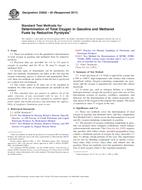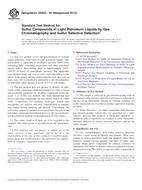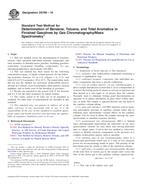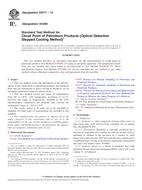We need your consent to use the individual data so that you can see information about your interests, among other things. Click "OK" to give your consent.
ASTM D7872-13
Standard Test Method for Determining the Concentration of Pipeline Drag Reducer Additive in Aviation Turbine Fuels
STANDARD published on 15.6.2013
The information about the standard:
Designation standards: ASTM D7872-13
Note: WITHDRAWN
Publication date standards: 15.6.2013
SKU: NS-39213
The number of pages: 5
Approximate weight : 15 g (0.03 lbs)
Country: American technical standard
Category: Technical standards ASTM
The category - similar standards:
Annotation of standard text ASTM D7872-13 :
Keywords:
DRA, GPC, jet fuel, rotary evaporation, total exclusion, ICS Number Code 75.160.20 (Liquid fuels)
Additional information
| Significance and Use | ||||||
|
5.1 DRA is frequently added into multiproduct pipelines to increase throughput or reduce energy requirements of fuel movement. Although these additives are not used in jet fuel, contamination can occur from other products if proper batching guidelines are not followed or by other cases of human error. CRC Report No. 642 reviewed the impact of DRA on jet fuel fit-for-purpose performance and concluded that the fuel spray angle and atomization capability of several engine-type fuel nozzles can be adversely affected impacting high altitude relight performance at elevated concentrations. A method that accurately quantifies the amount of DRA in jet fuel can be useful in confirming the absence of significant contamination to protect the safety of aviation operations. This test method is designed to measure down to sub-100 µg/L levels of DRA in aviation fuel. |
||||||
| 1. Scope | ||||||
|
1.1 This test method covers the measurement of high molecular weight polymers, in particular pipeline drag reducer additive (DRA), in aviation turbine fuels with a 72 µg/L lower detection limit. The method cannot differentiate between different polymers types. Thus, any non-DRA high molecular weight polymer will cause a positive measurement bias. Further investigation is required to confirm the polymer detected is DRA. 1.2 The values stated in SI units are to be regarded as standard. No other units of measurement are included in this standard. 1.3 Warning—Mercury has been designated by many regulatory agencies as a hazardous material that can cause central nervous system, kidney and liver damage. Mercury, or its vapor, may be hazardous to health and corrosive to materials. Caution should be taken when handling mercury and mercury containing products. See the applicable product Material Safety Data Sheet (MSDS) for details and EPA’s website — http://www.epa.gov/mercury/faq.htm — for additional information. Users should be aware that selling mercury and/or mercury containing products into your state or country may be prohibited by law. 1.4 This standard does not purport to address all of the safety concerns, if any, associated with its use. It is the responsibility of the user of this standard to establish appropriate safety and health practices and determine the applicability of regulatory limitations prior to use. |
||||||
| 2. Referenced Documents | ||||||
|
Similar standards:
Historical
1.5.2011
Historical
15.1.2014
Historical
1.6.2014
Historical
1.12.2012
Historical
1.5.2010
Historical
15.4.2012
We recommend:
Technical standards updating
Do you want to make sure you use only the valid technical standards?
We can offer you a solution which will provide you a monthly overview concerning the updating of standards which you use.
Would you like to know more? Look at this page.



 ASTM D5622-95(2011)..
ASTM D5622-95(2011).. ASTM D5623-94(2014)..
ASTM D5623-94(2014).. ASTM D5705-14
ASTM D5705-14 ASTM D5708-12
ASTM D5708-12 ASTM D5769-10
ASTM D5769-10 ASTM D5771-12
ASTM D5771-12
 Cookies
Cookies
